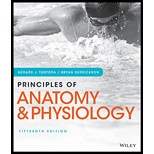
Principles of Anatomy and Physiology
15th Edition
ISBN: 9781119329398
Author: Gerard J Tortora, Bryan Derrickson
Publisher: John Wiley & Sons Inc
expand_more
expand_more
format_list_bulleted
Concept explainers
Question
Chapter 19, Problem 14CP
Summary Introduction
To review:
The meaning of differential white blood cell (WBC) count.
Introduction:
The blood is composed of three different types of cells, namely red blood corpuscles (RBCs), platelets, and WBCs. The WBCs impart immunity to the body. These cells are further of five different types, namely neutrophils, monocytes, lymphocytes, basophils, and eosinophils.
Expert Solution & Answer
Want to see the full answer?
Check out a sample textbook solution
Students have asked these similar questions
Briefly state the physical meaning of the electrocapillary equation (Lippman equation).
Explain in a small summary how:
What genetic information can be obtained from a Punnet square? What genetic information cannot be determined from a Punnet square?
Why might a Punnet Square be beneficial to understanding genetics/inheritance?
In a small summary write down:
Chapter 19 Solutions
Principles of Anatomy and Physiology
Ch. 19 - Prob. 1CPCh. 19 - What substances does blood transport?Ch. 19 - Prob. 3CPCh. 19 - Prob. 4CPCh. 19 - List the formed elements in blood plasma and...Ch. 19 - Prob. 6CPCh. 19 - Prob. 7CPCh. 19 - Describe the formation of platelets from...Ch. 19 - Prob. 9CPCh. 19 - Prob. 10CP
Ch. 19 - 11. What is erythropoiesis? How does...Ch. 19 - What is the importance of emigration, chemotaxis,...Ch. 19 - Prob. 13CPCh. 19 - Prob. 14CPCh. 19 - What functions do granular leukocytes,...Ch. 19 - How do RBCs, WBCs, and platelets compare with...Ch. 19 - Prob. 17CPCh. 19 - Prob. 18CPCh. 19 - Prob. 19CPCh. 19 - Prob. 20CPCh. 19 - Prob. 21CPCh. 19 - Prob. 22CPCh. 19 - What precautions must be taken before giving a...Ch. 19 - What is hemolysis, and how can it occur after a...Ch. 19 - Explain the conditions that may cause hemolytic...Ch. 19 - Shilpa has recently been on broad-spectrum...Ch. 19 - Prob. 2CTQCh. 19 - Prob. 3CTQ
Knowledge Booster
Learn more about
Need a deep-dive on the concept behind this application? Look no further. Learn more about this topic, biology and related others by exploring similar questions and additional content below.Similar questions
- Not part of a graded assignment, from a past midtermarrow_forwardNoggin mutation: The mouse, one of the phenotypic consequences of Noggin mutationis mispatterning of the spinal cord, in the posterior region of the mouse embryo, suchthat in the hindlimb region the more ventral fates are lost, and the dorsal Pax3 domain isexpanded. (this experiment is not in the lectures).a. Hypothesis for why: What would be your hypothesis for why the ventral fatesare lost and dorsal fates expanded? Include in your answer the words notochord,BMP, SHH and either (or both of) surface ectoderm or lateral plate mesodermarrow_forwardNot part of a graded assignment, from a past midtermarrow_forward
- Explain in a flowcharts organazing the words down below: genetics Chromosomes Inheritance DNA & Genes Mutations Proteinsarrow_forwardplease helparrow_forwardWhat does the heavy dark line along collecting duct tell us about water reabsorption in this individual at this time? What does the heavy dark line along collecting duct tell us about ADH secretion in this individual at this time?arrow_forward
arrow_back_ios
SEE MORE QUESTIONS
arrow_forward_ios
Recommended textbooks for you
 Human Biology (MindTap Course List)BiologyISBN:9781305112100Author:Cecie Starr, Beverly McMillanPublisher:Cengage Learning
Human Biology (MindTap Course List)BiologyISBN:9781305112100Author:Cecie Starr, Beverly McMillanPublisher:Cengage Learning- Surgical Tech For Surgical Tech Pos CareHealth & NutritionISBN:9781337648868Author:AssociationPublisher:Cengage


Human Biology (MindTap Course List)
Biology
ISBN:9781305112100
Author:Cecie Starr, Beverly McMillan
Publisher:Cengage Learning


Surgical Tech For Surgical Tech Pos Care
Health & Nutrition
ISBN:9781337648868
Author:Association
Publisher:Cengage

